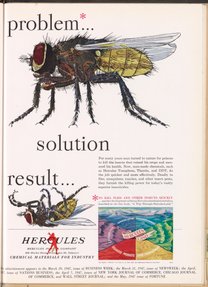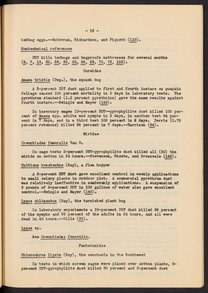DDT, the Synthetic Insecticide
- 1946

Rights
Download all 73 images
PDFZIPof full-sized JPGsDownload selected image
Small JPG1200 x 1753px — 530 KBFull-sized JPG2506 x 3660px — 1.9 MBOriginal fileTIFF — 2506 x 3660px — 26.2 MBA survey of variables in DDT application and their effects as determined by contemporary experimental research. Variables discussed include the type of surface to which the formula is applied, the manner and formulation in which the DDT is presented, climate conditions, the amount of rubbing to which the surface is subjected, and others, all of which may influence the efficacy of DDT. The volume is intended for the field worker who may not have access to literature on DDT, and focuses on practical applications of experimental research results.
DDT (dichloro-diphenyl-trichloroethane) was developed as a synthetic insecticide in the 1940s. It was initially used to combat malaria, typhus, and other insect-borne diseases. The EPA banned DDT in 1972 after research showed harmful impacts to wildlife and potential human health risks.
Digitized content includes the work's frontmatter and plates. This work is protected by copyright law; to view the full text, contact or visit the Othmer Library of Chemical History.
| Property | Value |
|---|---|
| Author | |
| Publisher | |
| Place of publication | |
| Format | |
| Genre | |
| Extent |
|
| Language | |
| Subject | |
| Rights | In Copyright |
| Rights holder |
|
| Credit line |
|
Institutional location
| Department | |
|---|---|
| Collection | |
| Physical container |
|
Learn More
Related Items
Cite as
West, T. F. (Trustham Frederick), and George A. Campbell. “DDT, the Synthetic Insecticide.” London, England: Chapman and Hall, 1946. SB952.D2 W47 1946. Science History Institute. Philadelphia. https://digital.sciencehistory.org/works/44f4e82.
This citation is automatically generated and may contain errors.
Rights
Download all 73 images
Searchable PDFmay contain errorsZIPof full-sized JPGsDownload selected image
-
Keyboard Shortcuts
Previous image shift + or , Next image shift + or . Pan image Zoom in + or shift + Zoom out - or shift + Zoom to fit 0 Close viewer esc Also
Mouse click to zoom in; shift-click to zoom out. Drag to pan. Pinch to zoom on touch.






















































